The Colonial Spanish Horse is a heritage breed, also commonly called the Spanish Mustang. Though the original Mustang descended from the Colonial Spanish horse, not all feral horses of the Americas today are of Colonial Spanish descent, as there has been considerable crossbreeding in some areas.
Colonial Spanish Horses descend from horses introduced from southern Spain, and possibly Abaco Barbs from North Africa, during the period of the conquest of the New World. A much smaller population of horses from Portugal called Sorraia also made it to the Americas via the Carribean Islands.
In the New World this colonial resource has become differentiated into a number of breeds, and the North American representatives are only a few of many such breeds throughout the Americas. These horses are a direct remnant of the horses of the Golden Age of Spain, which type is now mostly or wholly extinct in Spain.
Modern Colonial Spanish Horse breeds and types
There is a wide array of horses considered to be near-pure descendants of original Spanish stock, with a variety of names. Some of these include the following modern breeds or breed substrains:
- Spanish Colonial Breeds
- Abaco Barb
- Sorraia
- Iberian Sulphur Horse
- Mustang substrains considered to be Colonial Spanish:
- Gila Bend Mustang
- Kiger Mustang
- Pryor Mountain Mustang
- Spanish Mustang
- Wilbur-Cruce Mission Horse
- Sulphur Mustang/Sulphur Horse
Since a lot of crossbreeding occurred on the original Spanish base, the overall goal of conservers of the Spanish Mustang has been to eliminate crossbred horses while trying to include all purely Spanish horses. The three main tools for evaluating horses are the history behind the individual horse, the appearance of the horse, and blood type of the horse.
None of these is a perfect mechanism in all cases. The history can point to either a prolonged existence as an isolated group, or to repeated crosses. The history desired is that of an isolated group. Of course, the type of horses that went into the isolation is as important as the fact of the isolation. If crossbreed’s went into it, crossbreed’s come out. That is why history alone cannot fully determine if a group is Spanish or not, but rather must be considered with respect to the external appearance, and sometimes with the blood type as well.
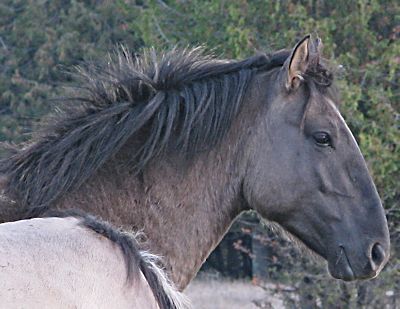 The Sorraia is a rare breed of horse indigenous to the portion of the Iberian peninsula, in the Sorraia River basin, in Portugal. These horses have good endurance and are easy keepers, thriving on relatively little fodder. They have a reputation for being independent of temperament.
The Sorraia is a rare breed of horse indigenous to the portion of the Iberian peninsula, in the Sorraia River basin, in Portugal. These horses have good endurance and are easy keepers, thriving on relatively little fodder. They have a reputation for being independent of temperament.
On adult horses, the lay of the hair can create the appearance of stripes or “barring” on the neck and chest. Also due to the lay of the hair, newborn foals can appear to have stripes all over, reminiscent of zebra stripes. The breed standard refers to this as “hair stroke.” The Sorraia also often has a roman nose.
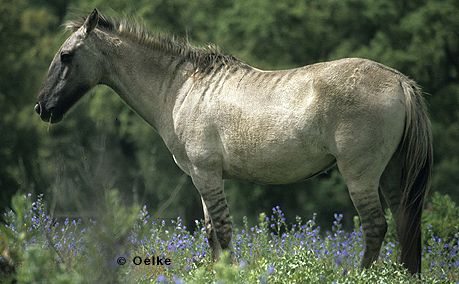 Multiple authors have suggested that the Sorraia might be a descendant of the Tarpan based on shared morphological features, principally the typical color of its coat. Analysis of mtDNA has been performed on Mustangs in the western United States that show similar mtDNA patterns between some Mustangs and the Sorraia breed.
Multiple authors have suggested that the Sorraia might be a descendant of the Tarpan based on shared morphological features, principally the typical color of its coat. Analysis of mtDNA has been performed on Mustangs in the western United States that show similar mtDNA patterns between some Mustangs and the Sorraia breed.
In the time of Christopher Columbus, the Sorraia was also known as the Marismeño, but the Sorraia and the Marismeño have evolved into two different breeds over time.
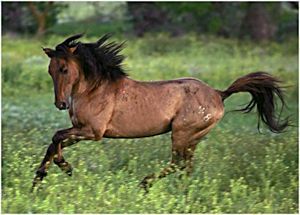 The Gila Bend Mustangs look very similar to each other and are mainly duns. There are several grullo horses, two roan duns and one black stallion. All the Gila horses have primitive markings that consist of zebra stripes and webbing noted on their
The Gila Bend Mustangs look very similar to each other and are mainly duns. There are several grullo horses, two roan duns and one black stallion. All the Gila horses have primitive markings that consist of zebra stripes and webbing noted on their
legs.
They have a rather thick dorsal stripe down their backs with some as wide as three inches. Many of them have dark faces and their ears are outlined with a black stripe. They have dark shading over their withers. Their coats are short and thick during the winter while the summers find them smooth and slick. These horses are 14 hands high and weigh approximately 800 to 850 pounds.
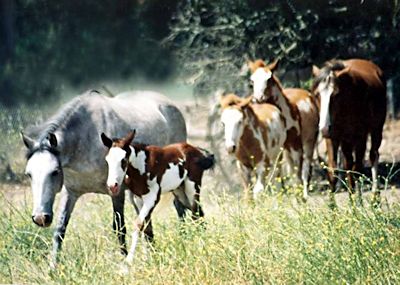 The Wilbur-Cruce Mission Horses lived isolated for more than 100 years on a remote ranch in southern Arizona under harsh conditions. Oral history as well as blood typing confirms the uniqueness of this herd which today consists of about 120 horses.
The Wilbur-Cruce Mission Horses lived isolated for more than 100 years on a remote ranch in southern Arizona under harsh conditions. Oral history as well as blood typing confirms the uniqueness of this herd which today consists of about 120 horses.
This particular herd of horses had an unusual history which traced directly back to a group of twenty six horses purchased for ranch use in 1885. These, in turn were descendants of the high quality stock used to supply the mission chain from Mexico into Arizona during the late 1600’s and early 1700’s.
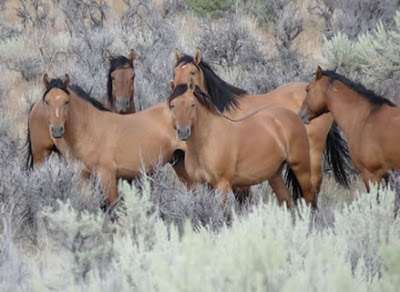 The Kiger Mustangs were discovered in a remote area in southeast Oregon in the 1970s and are thought to be the purest descendant of horses brought to North America by the Conquistadors.
The Kiger Mustangs were discovered in a remote area in southeast Oregon in the 1970s and are thought to be the purest descendant of horses brought to North America by the Conquistadors.
Upon capture the animals were all found to exhibit the primitive markings of the dun color modifier. DNA testing showed that these horses were genetically related to 17th century Spanish breeds.
The Kiger were separated from the other mustangs collected in Oregon in order to breed in captivity. It became one of the purest mustang breeds, and many Kiger Mustangs can be traced back to a single stallion called Mesteño.
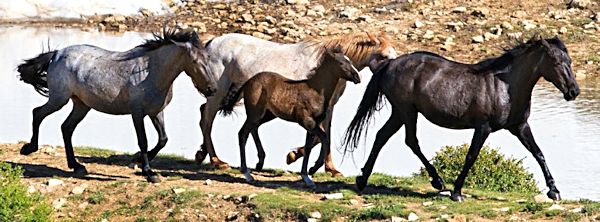
The Pryor Mountain Mustangs get their name from their home in the Prior Mountain Range extending from near Lovell, Wyoming into Montana. They are thought to be descended from the colonial horses of Portugal and Spain.
Feral horses are documented to have been living in the Pryor Mountains by the early 1700s, although they may have been there since the late 1600s.
Starting in the mid-1990’s, studies were done on the Pryor Mountain Wild Horses to determine genetic traits of the herd, such as their level of inbreeding and what type of horse the herd was most genetically related to.
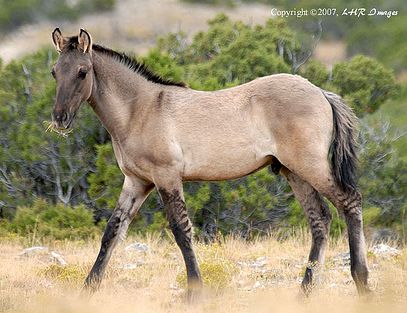 From these studies, it was determined that the herd has high genetic diversity, meaning they have low levels of inbreeding. It was also determined that the herd has genetic traits consistent with Spanish horses and that the herd lacks genetic traits that would have originated in draft or thoroughbred ancestors.
From these studies, it was determined that the herd has high genetic diversity, meaning they have low levels of inbreeding. It was also determined that the herd has genetic traits consistent with Spanish horses and that the herd lacks genetic traits that would have originated in draft or thoroughbred ancestors.
Pryor Mountain Mustangs are relatively small horses, exhibit a natural ambling gait, and domesticated Pryor Mountain Mustangs are known for their strength, sure-footedness and stamina.
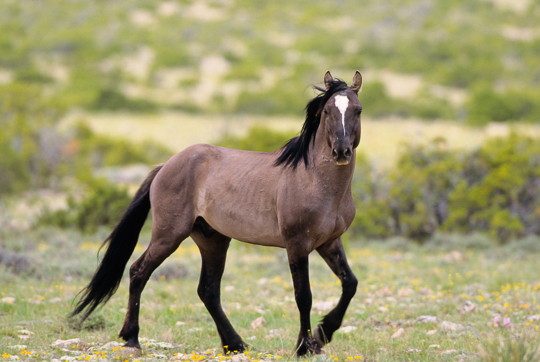 The Sulphur Herd Management area horses that are present as adopted horses in the Salt Lake City area appear to be of Spanish phenotype. The horses are reasonably uniform in phenotype, and most of the variation encountered could be explained by a Spanish origin of the population. That, coupled with the remoteness of the range and blood typing studies, suggests that these horses are indeed Spanish.
The Sulphur Herd Management area horses that are present as adopted horses in the Salt Lake City area appear to be of Spanish phenotype. The horses are reasonably uniform in phenotype, and most of the variation encountered could be explained by a Spanish origin of the population. That, coupled with the remoteness of the range and blood typing studies, suggests that these horses are indeed Spanish.
Detailed historical background of the Sulphur herd management area horses is not available. The limited amount of history available points to this population being an old one, with limited or no introduction of outside horses since establishment of the population. The foundation of the herd is logically assumed to be Spanish, since this was the only resource available at the time of foundation.
Spanish type includes sloping croup low set tail, deep body, narrow chest, deep Roman nosed head from side view, broad forehead but narrow face and muzzle from front view, eyes place on side of head, small ears with inwardly hooked tips, small or absent rear chestnuts, small front chestnuts, potential of long hairs on stern area and chin.
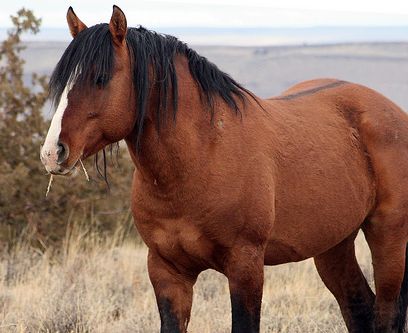 All colors are possible, although a high proportion of black and its derivatives are consistent with a Spanish origin. Line backed duns, roans, buckskin/palomino, sabino and overo paint, and the leopard complex are also usually Spanish in origin, and grey and tobiano can be. It is frequently the mix of colors and their relative frequency in the population that is more important than the presence of or absence of any one color.
All colors are possible, although a high proportion of black and its derivatives are consistent with a Spanish origin. Line backed duns, roans, buckskin/palomino, sabino and overo paint, and the leopard complex are also usually Spanish in origin, and grey and tobiano can be. It is frequently the mix of colors and their relative frequency in the population that is more important than the presence of or absence of any one color.
The origin of these horses is shrouded in myth and speculation. Opinions vary, with one extreme holding that these are an unique subspecies of horse, to the other extreme that they are a more recent amalgamation of Northern European types with oriental horses. Somewhere in between is the view that these are predominantly of North African Barb breeding.
This historically important Spanish horse has become increasingly rare, and was supplanted as the commonly used improver of indigenous types by the Thoroughbred and Arabian. These three (Spanish, Thoroughbred, and Arabian) are responsible for the general worldwide erosion of genetic variability in horse breeds. The Spanish type subsequently became rare and is now itself in need of conservation. The horse currently in Spain is distinct, through centuries of divergent selection, from the Colonial Spanish Horse. The result is that the New World remnants are very important to overall conservation since the New World varieties are closer in type to the historic horse of the Golden Age of Spain than are the current horses in Iberia.
Colonial Spanish Horses are rarely referred to by this name. The usual term that is used is Spanish Mustang. At one time (about 1700) the purely Spanish horse occurred in an arc from the Carolinas to Florida, west through Tennessee, and then throughout all of the western mountains and Great Plains.
In the northeast and central east the colonists were from northwest Europe, and horses from those areas were more common than the Colonial Spanish type. Even in these non-Spanish areas the Colonial Spanish Horse was highly valued and did contribute to the overall mix of American horses. Due to their wide geographic distribution as pure populations as well as their contribution to other crossbred types, the Colonial Spanish Horses were the most common of all horses throughout North America at that time, and were widely used for riding as well as draft.
In addition to being the common mount of the native tribes (some of whom measured wealth by the number of horses owned) and the white colonists there were also immense herds of feral animals that descended from escaped or strayed animals of the owned herds.
The Colonial Spanish horse came to be generally considered as too small for cavalry use by the whites, and was slowly supplanted by taller and heavier types from the northeast as an integral part of white expansion in North America.
In the final stages this process was fairly rapid, and was made even more so by the extermination of the horse herds of the native Americans during the final stages of their subjection in the late 1800’s.
The close association of the Spanish Horse with both native American and Mexican cultures and peoples also caused the popularity of these horses to diminish in contrast to the more highly favored larger horses of the dominant Anglo derived culture, whose horses tended to have breeding predominantly of Northern European types. The decline of the Colonial Spanish horse resulted in only a handful of Spanish horses left in isolated pockets from the once vast herds.
